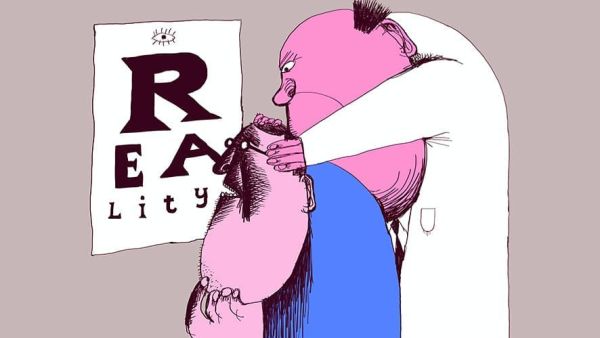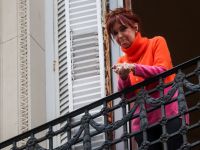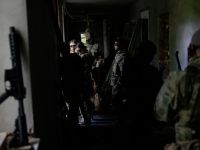Ghida Hachicho’s 2020 short “A crowd forms, partly planned and partly improvised,” is an unconventional depiction of popular demonstration.
The video is among the first works visitors would see upon entering “20/20/On/Offline,” one of two shows currently locked-down at Beirut Art Center.
“A crowd forms” is based on footage and photos of a popular demonstration in 1987. First, the festive sounds of a mass demo play out to a black screen. The sound design drops to sotto voice, then, as a video camera pans over a black-and-white still of the protest. A few seconds of color footage follows, showing demonstrators silently clapping.
Subtitles complement the images, quoting a man’s recollections of his walk that day. The “walk” may be the mass gathering in the footage – uncertain because the protesters’ aims, and the issues provoking the demo, are never mentioned.
“I have little memory in my body, what I have danced, but I remember how the street suddenly had only one direction,” he says. “I remember the clapping was the only way to estimate the numbers.”
The informant’s reflections are followed by subtitular narration describing collective political action in terms akin to a dance performance.
“A crowd forms” resonates with Hachicho’s past visual art, grounded in training in architecture and contemporary dance. This brief work is also resonant of the Lebanese experience since October 2019, focussing on the sometimes inchoate (“political” yet nonpartisan) compulsions driving mass action.
“20/20/On/Offline” exhibits work by 19 Lebanese artists, all commissioned and exhibited in 2020 by two of BAC’s online initiatives – Micro-commissions and “The Derivative,” its publication platform.
Across the hall from “20/20,” is Mohammed Berro’s solo “to live and let live.” This exhibition grew out of his three-month BAC residency in 2019. The artist did fieldwork in The Free Republic of Liberland, a self-styled libertarian utopia occupying a seven-square-km area wedged between Croatia and Serbia.
Days after opening, both these exhibitions were interrupted by Lebanon’s anti-pandemic measures of November 2020. Thanks to the January 2021 lockdown, they’re presently shuttered again.
What is the language of predictions, and how are they present in our daily lives? #AFAC_Grantee in Performing Arts Wael Ali’s project “Apocalypse” questions the notion of predictions as a way to read a world that appears illegible.#AFAC #Performing_Arts #Syria #predictions pic.twitter.com/OLSqwymun4
— The Arab Fund for Arts and Culture - AFAC (@AFAC1) September 17, 2018
Last year saw artists Haig Avazian and Ahmad Ghossein appointed BAC’s co-artistic directors. In an interview late last year, Avazian described the Micro-commissions as a way to remain active in the art sector’s contracting circumstances.
“The idea came from a restricted access to dollars, restrictions to accessing the space due to COVID-19, the mental or emotional restrictions of attention spans unable to concentrate on long-term projects,” he said. “So we thought we’d prompt artists based on small assignments and launch these assignments online.
“The idea was that every month we’d come up with an idea and prompt four artists to make a work based on a theme, with a modest budget in Lebanese lira.”
True to its name, “20/20” is suffused with the emotions that seeped from 2020. Works aren’t necessarily interested in illustrating “uprising,” “bank robbery,” “criminal negligence” and such, but a number of artists have revisited Beirut’s Aug. 4 Port blast. In contrast, a work like “A crowd forms” might have been conceived at any time, but latent political outrage inflects how it’s read.
Though it’s likely more people would’ve found these works on Instagram or SoundCloud than at BAC, the center has made an effort to stage “20/20” as a coherent show.
There are pleasures in encountering these works physically and collectively (they’re clustered by commission, for instance, highlighting their shared inspiration) but the results are uneven. Depending on the media, some works are better appreciated online – a matter of current contingencies more than organisational competence.
Titled “All Hands on Deck,” Micro-commissions 1 invited artists to devise “quick, short, simple gestures” in response to the theme of “hands” (washing hands, holding hands, germaphobe hands, idle hands, etc).
Hachicho’s work is most evocative of the popular protests that Lebanon’s economic despair and public health disaster have done much to suffocate.
More mischievous is Myriam Boulos’ “I only feel connected to my body when I am horny.” The portrait-shaped photo of a female hand in profile shows bloodied index and middle fingers.
It’s the only work in the physical expo accompanied by an exhibition tag, which reads, “I have always felt a deep link between the body and the city I live in. I have almost always felt like a stranger in both.”
The bloodied hand is reminiscent of Boulos’ portraits of port explosion survivors. The accompanying text tugs readings toward “self-abuse” – which, in English at least, can suggest both self-gratification and self-harm, of the individual and the body politic.
Excluded from “20/20” is Yalda Younes’ “Zamharir,” which concluded (and inspired) “All Hands on Deck.” This engagingly frenetic video captures the dancer-choreographer’s playful response to a piece of electronic music her collaborator Khyam Allami composed while they were separately locked-down. A hands-only performance, it is literally gestural.
The sole “old media” contribution to this first round of micro-commissions is Carla Habib’s “Softhands,” an eight-frame comic showing a pair of hands washing themselves, drawn from the perspective of the hand-washer. The artist is selective in what her subject “sees.” While all frames include tiles, sink and faucet, the subject’s face is reflected in the bathroom mirror only when it’s being washed, when eyes become visible through his/her hands. This pliable materiality is evident again while the cleaned hands towel off and reach for a handgun, left off-frame until then.
There are several series of works-on-paper exhibited in “20/20.”
Micro-commission 2, “I Draw the Line Here,” invited five illustrators to reflect upon the “now” that was then. Nour Hifaoui Fakhoury, Tracy Chahwan, Mohamad Kraytem, Raphaelle Macaron, and Bahij Jaroudi each responded with a series of graphic novel-esque works, whose styles and subjects range from amusingly reflective to in-your-face provocative – in the Lebanese context anyway.
In addition, “The Derivative” has contributed two series of illustrations. The second curatorial element of “20/20,” BAC’s online publication warrants consideration on its own. Accessible via BAC’s website, each of the three discrete components (or cycles) of “The Derivative” has been developed by a different editor, working with several contributing writers and artists. Online reproductions of work and SoundCloud links are embedded in the texts.
3 days left for HW8! Two artist project will open at Agial Art Gallery on October 17th, at 3pm: Studies on movement by Ghida Hachicho and Schmitt, You and Me by Omar Mismar. @ashkal_alwan pic.twitter.com/9vc3gpxUNS
— Agial Art Gallery (@AgialArt) October 14, 2019
Works by Sarah Saroufim emerged from the “Reverberations” cycle, edited by Rayya Badran. Hatem Imam’s series adorns Hisham Awad’s “Number.” Both illustrators are accomplished, but Imam’s pieces are distinct inasmuch as they seem consistently undersized relative to their themes – both in the physical prints hung at BAC and those embedded online, where they tend to be smaller than their allotted spaces.
The writing in “The Derivative” is always engaging – especially for readers interested in contemporary criticism’s magpie-like, often academically informed, engagement with shiny shards of today.
The impact of Lebanon’s recent troubles upon the art of “20/20” is evident in “Insecure.” Micro-commissions 3 invited four filmmakers and videographers to each make a five-minute short using only the six CCTV cameras monitoring BAC’s interior halls.
The four teams were working on these commissions on Aug. 4. As Avazian told The Daily Star, one crew was onsite when the port blast ripped the center’s metallic front door off its hinges and collapsed its back wall.
As the explosion tore such a ragged swath through Beirut’s cultural community, the security camera documentation of the shockwave imposed itself on these projects.
Among the more accomplished of these works is Lara Tabet’s “Parasomnia” (the clinical term for nocturnal activities like sleep walking).
Black-and-white CCTV footage shows three figures moving through the space – a cat, a concierge on his rounds, and a nude young woman. At one point she pauses to stare directly into a camera, and the footage of the blast is superimposed over her vulnerable form.
After a brief montage of security camera vistas of the shockwave (sampled by most of the “Insecure” works), the media and location shift beyond the commission’s parameters, closing with a color montage of microbial-level cell division. The feedback-scarred, overlapping voices of Nour Sokhn’s “The State - Remix,” the score accompanying the CCTV sequences, are displaced by a snippet from Beethoven’s “Tempest Sonata” for piano.
The other three contributions restrict themselves to CCTV footage alone. All of them also refer to various bits of writing.
Malak Mroueh’s “Emergence” quotes lines from Maurice Blanchot’s philosophical treatise “The Writing of the Disaster,” notably “The disaster ruins everything, leaving every thing intact.” Panos Abrahamian’s “Billy Pilgrim has become unstuck in time” concludes with a quotation from Kurt Vonnegut’s sci-fi-inflected 1969 novel “Slaughterhouse Five,” from which it also takes its title.
Danielle Davie’s “Singeuse” (Singer) suggests the parallel stories of two young women in one space. One, working on a project that involves writing on a long paper scroll, devotes much energy to finding a comfortable writing position. The other figure pantomimes gestures of increasingly agitated insecurity.
Davie’s penultimate gesture is a few lines in French, seemingly of her own devising.
“The violence of the explosion broke time. It changed the meaning of our inscription in this space. The images of our bodies are archives of a future that we repeat. There is a reversal of the fiction and the real event as such.”
As noted, not all the works in “20/20” are equally well served by the migration from cyberspace to space. Take the diverse series of six elaborate sound works by Rayan Abdel Khele, Sandy Chamoun, Aya Atoui, Renata Sabella, and Leil Zahra, originally composed for Edwin Nasr’s “Individual,” the third cycle of “The Derivative.” These are looped in a darkened room with a limited expanse of floor for listeners to recline. It’s not the most inviting exhibition format and invariably leaves individual works unreferenced.
Ultimately “20/20” feels more like an arrangement of pieces than a conventionally curated group show. So it should. If an exhibition were justifiably disjointed, out of place and alienating, it would be one formed in the crucible of 2020.
This article has been adapted from its original source.








